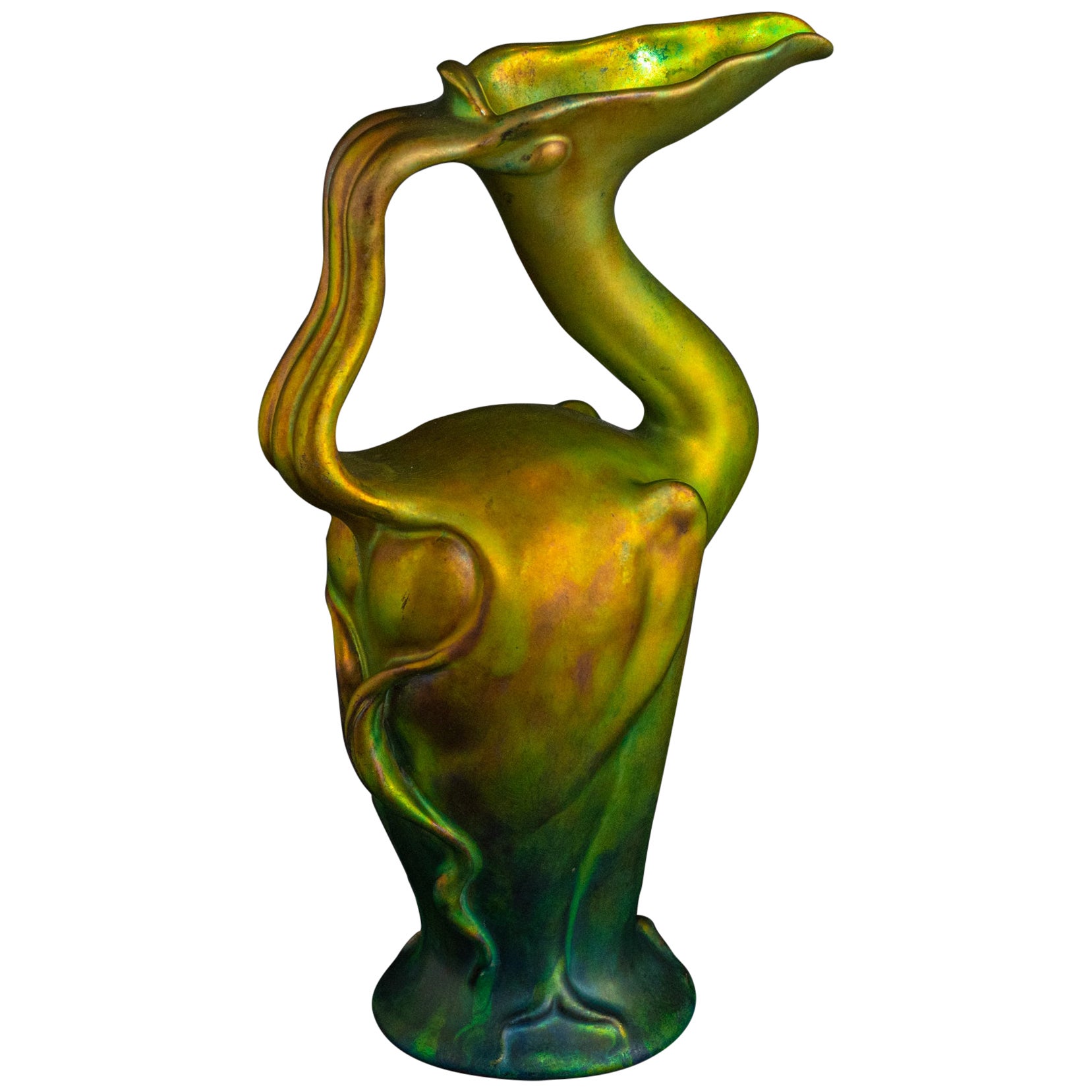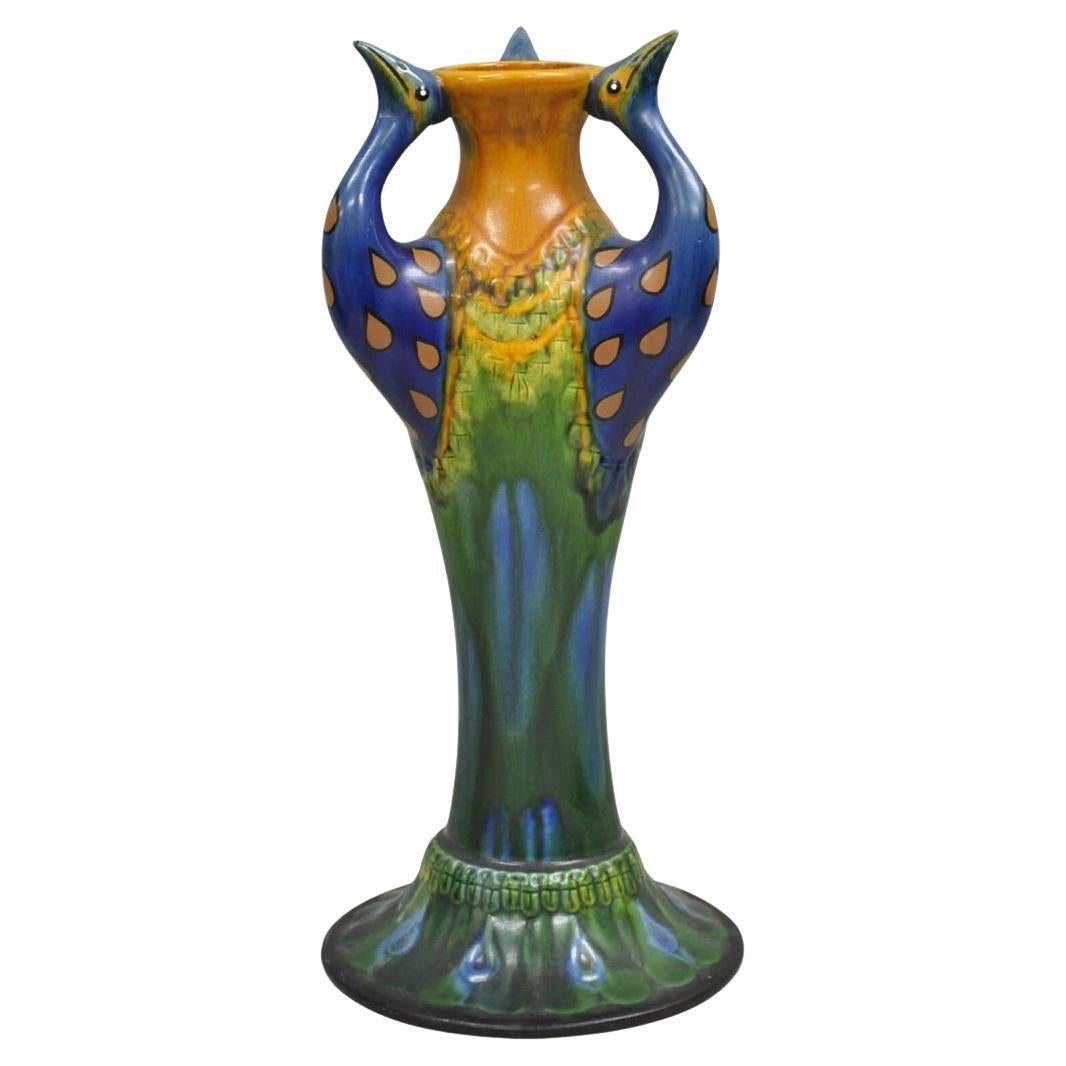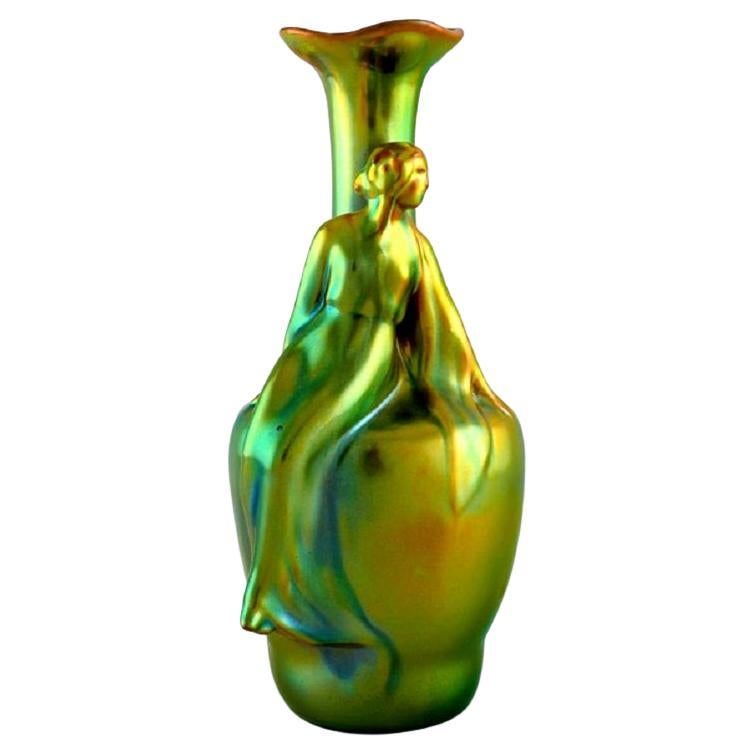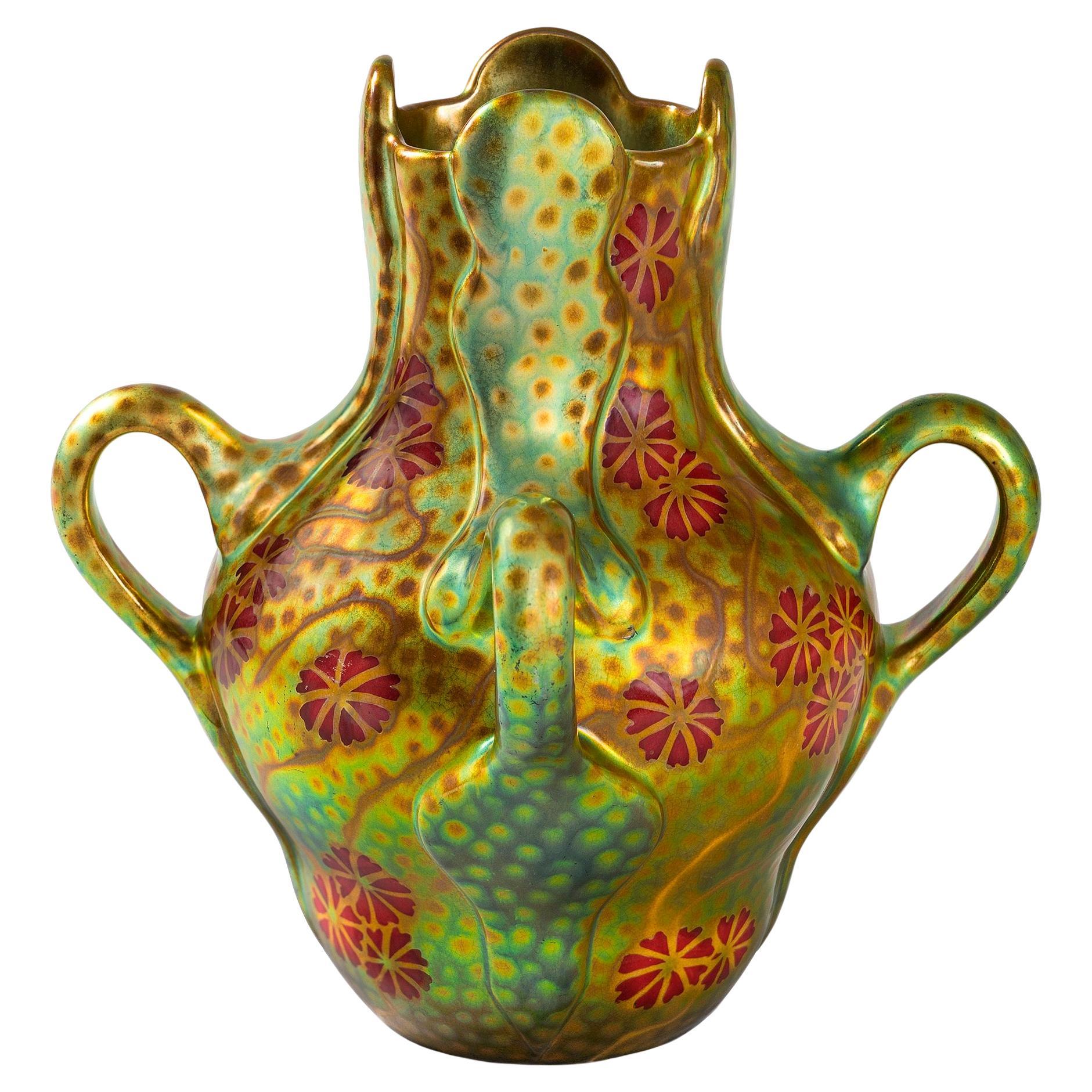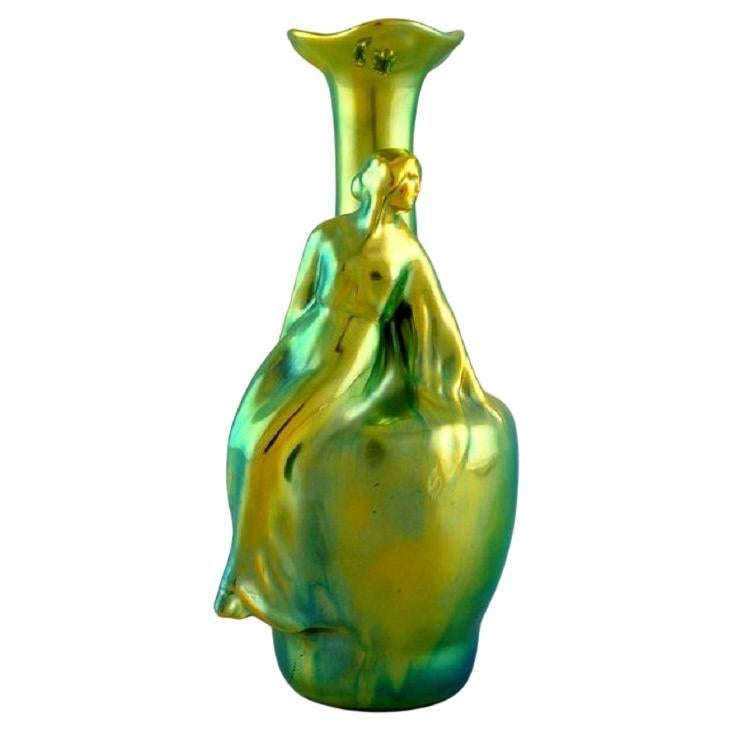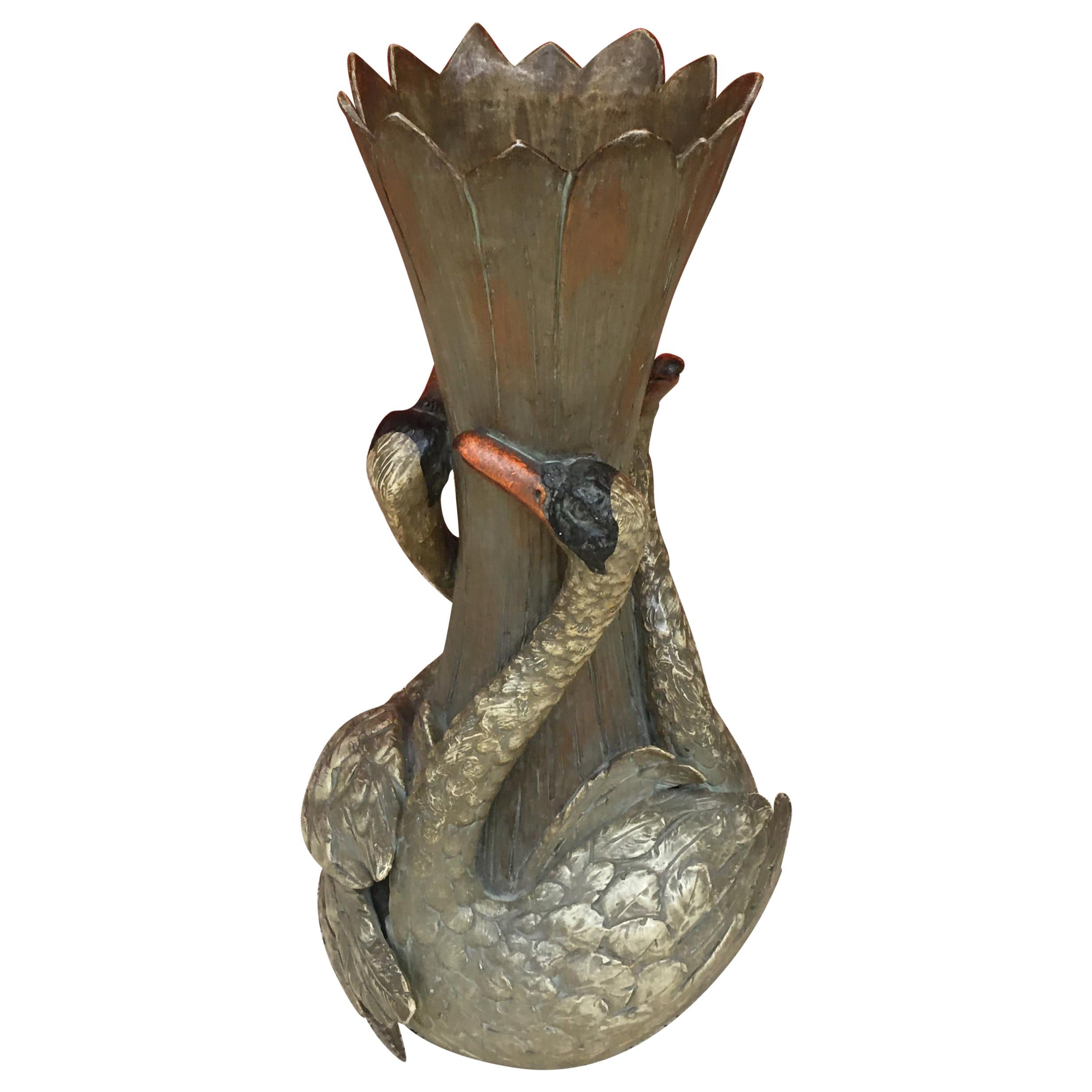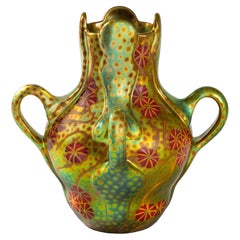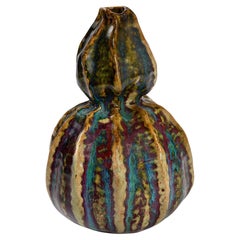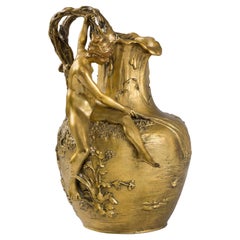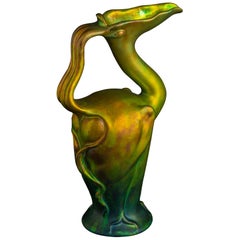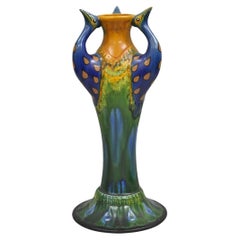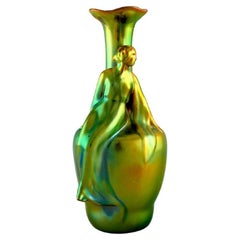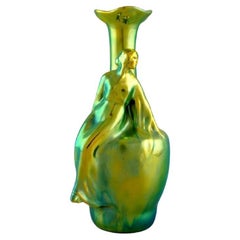Items Similar to Zsolnay "Bird and Tulip" Glazed Ceramic Ewer
Want more images or videos?
Request additional images or videos from the seller
1 of 7
Zsolnay "Bird and Tulip" Glazed Ceramic Ewer
$28,000
£21,130.83
€24,191.61
CA$39,489.28
A$43,354.31
CHF 22,618.03
MX$524,647.49
NOK 283,481.96
SEK 267,114.54
DKK 180,583.88
About the Item
This resplendent Zsolnay bird ewer—resting on three feet and crowned with a blooming tulip handle—is a triumph of Art Nouveau design, created by Sándor Apáti-Abt for the Zsolnay manufactory. Its form draws inspiration from Bronze Age Hungarian askoi, zoomorphic vessels historically used in shamanistic rituals. Excavated from cemeteries across Hungary in the 19th century, these ancient artifacts captivated local artists and scholars alike. Some surviving askoi, now housed in Budapest museums, depict human–bird hybrids and were found to contain traces of blood or psychoactive substances. It is believed that shamans consumed these liquids during ceremonies to undergo spiritual transformation—temporarily assuming the identity of birds, aided by avian spirit guides. By the Late Bronze Age, askoi often took the shape of waterfowl—creatures able to traverse land, water, and air—reflecting their symbolic resonance with multiple cosmological realms.
This concept of metamorphosis strongly resonated with Art Nouveau’s fascination with the natural world and the fantastical, where hybrid forms—fusing flora and fauna—embodied mythological and spiritual transcendence. At the same time, Zsolnay was incorporating ideas from contemporary esoteric movements such as Theosophy, Anthroposophy, and Zoroastrianism. These belief systems merged ancient religious traditions with modern philosophies, encouraging a return to the spiritual imagination of the past.
Item #: C-21960
Artist: Zsolnay
Country: Hungary
Circa: 1899
Materials: Eosin glazed earthenware
Exhibition History: in the Zsolnay Museum in Pécs, Hungary. (Part of the Gyugyi Collection)
Macklowe Gallery Curator's Notes:
Founded in 1853 by Miklós Zsolnay, the Zsolnay manufactory flourished in the city of Pécs, which became the center of Hungary’s ceramic innovation. Under the leadership of his son Vilmos Zsolnay from 1865, the firm gained international acclaim through participation in world fairs and exhibitions. Vilmos also spearheaded technical experimentation by bringing in chemists Vince Wartha and Lajos Petrick, who developed the eosin glazing process in 1893. This complex technique, which involves the use of metallic oxides in a lead-based glaze, creates a shimmering, iridescent surface that shifts in color with changing light. The name "eosin" is derived from Eos, the Greek goddess of dawn—a nod to the pinkish hue of the earliest successful glazes. Over time, a full spectrum of colors was developed, including the glowing green-gold seen on this ewer. The piece dazzles with a kaleidoscope of hues, its surface alive with the fluid poetry of botanical curves—an embodiment of Zsolnay’s mastery of both mythic imagination and material innovation.
- Creator:Zsolnay (Workshop/Studio)
- Dimensions:Height: 10 in (25.4 cm)Width: 10 in (25.4 cm)Depth: 6 in (15.24 cm)
- Style:Art Nouveau (Of the Period)
- Materials and Techniques:
- Place of Origin:
- Period:
- Date of Manufacture:1899
- Condition:
- Seller Location:New York, NY
- Reference Number:1stDibs: LU885445448182
About the Seller
4.8
Recognized Seller
These prestigious sellers are industry leaders and represent the highest echelon for item quality and design.
Established in 1971
1stDibs seller since 2010
48 sales on 1stDibs
Typical response time: 13 hours
- ShippingRetrieving quote...Shipping from: New York, NY
- Return Policy
Authenticity Guarantee
In the unlikely event there’s an issue with an item’s authenticity, contact us within 1 year for a full refund. DetailsMoney-Back Guarantee
If your item is not as described, is damaged in transit, or does not arrive, contact us within 7 days for a full refund. Details24-Hour Cancellation
You have a 24-hour grace period in which to reconsider your purchase, with no questions asked.Vetted Professional Sellers
Our world-class sellers must adhere to strict standards for service and quality, maintaining the integrity of our listings.Price-Match Guarantee
If you find that a seller listed the same item for a lower price elsewhere, we’ll match it.Trusted Global Delivery
Our best-in-class carrier network provides specialized shipping options worldwide, including custom delivery.More From This Seller
View AllZsolnay "Japanese Cosmos" Glazed Ceramic Vase
By Zsolnay
Located in New York, NY
This evocative Japonist vase was designed by Sándor Apáti Abt for the Hungarian ceramic factory Zsolnay. The vase features a radiant background of gold, green, and orange, and is ado...
Category
Early 20th Century Hungarian Art Nouveau Vases
Materials
Earthenware
Pierre-Adrien Dalpayrat "Colocynth" Glazed Ceramic Vase
By Pierre-Adrien Dalpayrat
Located in New York, NY
A two tiered "Colocynth" ceramic vase by Pierre-Adrien Dalpayrat featuring his celebrated, earthen tone glazes in hues of turquoise, burgundy, moss an...
Category
Early 20th Century French Art Nouveau Vases
Materials
Ceramic
Pierre-Adrien Dalpayrat Glazed Ceramic Vase
By Pierre-Adrien Dalpayrat
Located in New York, NY
Pierre-Adrien Dalpayrat's signature ruby-cranberry-crimson glaze is at the forefront of this exciting composition, an arresting design featuring strong c...
Category
Early 20th Century French Art Nouveau Vases
Materials
Ceramic
Alexandre Vibert "La Pêche Au Filet" Ormolu Ewer
By Alexandre Vibert
Located in New York, NY
This "La Pêche Au Filet" ormolu ewer by Vibert is intricately adorned with a sculptural depiction of the naiad Daphne, who clings to a handle shaped like a laurel tree. She is seated...
Category
Early 20th Century French Art Nouveau Vases
Materials
Ormolu
Daum Nancy "Fleurs et Abeilles" Enameled and Etched Glass Vase
By Daum
Located in New York, NY
This French Art Nouveau enameled and etched "Fleurs et Abeilles" glass vase by Daum Nancy features an unusual and wildly undulating form that is countered neatly by the tightly executed landscape that decorates its organic curves, bulges, dips and valleys. Climbing from a deeply, darkly colored base upward to the bright, nearly translucent bright yellow rim of the vase are a field of ultra-finely rendered red orchid blooms with framing leaves...
Category
Antique Early 1900s French Art Nouveau Vases
Materials
Art Glass
Daum Nancy "Avoine et abeilles" Vase
By Daum
Located in New York, NY
This French Art Nouveau Glass Vase by Daum features ruby-toned handles and bees buzzing amongst the variously colored foliage featured on the vessel. The vase utilizes the famous Dau...
Category
Early 20th Century French Art Nouveau Vases
Materials
Enamel
You May Also Like
Surrealist Art Nouveau Bird Ewer by Sándor Apáti-Abt for Zsolnay
By Sándor Apáti Abt, Zsolnay
Located in Chicago, US
Established in 1853 by Miklós Zsolnay, Zsolnay began as a small business producing basic stoneware and earthenware. Ten years later Miklós’ son, Vilmos, joined the company and led it...
Category
Antique Early 1900s Hungarian Art Nouveau Vases
Materials
Earthenware
Vintage Art Nouveau Majolica Style Glazed Ceramic Pottery Peacock Bird Vase
Located in Philadelphia, PA
Vintage Art Nouveau Majolica Style Glazed Ceramic Pottery Peacock Bird Vase. Circa Mid 20th Century. Measurements: 16.5" H x 7.5" W x 7.5" D.
Category
Mid-20th Century Unknown Art Nouveau Vases
Materials
Ceramic
Zsolnay Art Nouveau Vase in Glazed Ceramics Modelled with Sitting Woman
Located in København, Copenhagen
Zsolnay Art Nouveau vase in glazed ceramics modelled with a sitting woman.
Beautiful eosin glaze. 1920/30s.
Measures: 24 x 13 cm.
In excellent condition.
Stamped.
Category
Vintage 1920s Hungarian Art Nouveau Vases
Materials
Ceramic
Zsolnay Art Nouveau Vase in Glazed Ceramics Modelled with a Sitting Woman
Located in København, Copenhagen
Zsolnay Art Nouveau vase in glazed ceramics modelled with a sitting woman. Beautiful eosin glaze. 20th Century.
Measures: 24 x 13 cm.
In excellent condition.
Stamped.
Category
20th Century Hungarian Art Nouveau Vases
Materials
Ceramic
Large Art Nouveau Terracotta Vase with Swans Decoration, Signed, circa 1900
Located in Saint-Ouen, FR
Large Art Nouveau terracotta vase with swans decoration, signed, circa 1900.
Category
Antique Late 19th Century European Art Nouveau Vases
Materials
Terracotta
Monumental Austrian Glazed Faience Bird motif Vase by Gerbing & Stephan
Located in New York, NY
Monumental Art Nouveau period ceramic vase by the Austrian firm of Gerbing and Stephan, circa 1890s, measuring 32.5 inches and depicting exotic bir...
Category
Antique Late 19th Century Austrian Art Nouveau Vases
Materials
Faience
More Ways To Browse
Ewers
Antique Ewer
Shaman Antique
Gunnar Nylund Collection
Hildegard Delius
Ida Meisinger
Iittala Vintage Blue
Ingeborg Lundin Apple
Iridescent Red Glass
Islamic Pottery Vases
Italian Double Handle Vase
Ivy Vase
James Powell And Sons
Japanese Red Ceramic Vase
Jean Gerbino Mosaic Vase
Loetz Glass On Sale
Joseon Pottery
Kosta Boda Vase Purple
